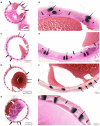VIVA Stent Preclinical Evaluation in Swine: A Novel Cerebral Venous Stent with a Unique Delivery System
- PMID: 40649095
- PMCID: PMC12250672
- DOI: 10.3390/jcm14134721
VIVA Stent Preclinical Evaluation in Swine: A Novel Cerebral Venous Stent with a Unique Delivery System
Abstract
Background: Venous sinus stenting is a promising treatment for intracranial venous disorders, such as idiopathic intracranial hypertension and pulsatile tinnitus, associated with transverse sinus stenosis. The VIVA Stent System (VSS) is a novel self-expanding braided venous stent designed to navigate tortuous cerebral venous anatomy. This preclinical study assessed the safety, thrombogenicity, and performance of the VSS in a swine model. Methods: Fifteen swine underwent bilateral internal mammary vein stenting with either the VSS (n = 9) or the PRECISE® PRO RX stent (n = 6, reference). Fluoroscopy and thrombogenicity assessments were conducted on the day of stenting, clinical pathology analysis was carried out throughout the in-life phase, and CT Venography was performed before sacrifice. Animals were sacrificed at 30 ± 3 or 180 ± 11 days post-stenting for necropsy and histological evaluation. Results: Fluoroscopic angiography confirmed the successful VSS deployment with complete venous wall apposition and no vessel damage. The VSS achieved the highest scores on a four-point Likert scale for most performance parameters. No thrombus formation was observed on either delivery system. CT Venography confirmed vessel patency, no stent migration, and complete stent integrity. Histopathology showed a mild, expected foreign body reaction at 30 days, which resolved by 180 days, indicating normal healing progression. Both stents showed increased luminal diameter and decreased wall thickness at 180 days, suggesting vessel recovery. No adverse reactions were observed in non-target organs. Conclusions: The VSS exhibited favorable safety, procedural performance, and thromboresistance in a swine model, supporting its potential clinical use for treating transverse sinus stenosis and related conditions.
Keywords: VIVA Stent System; preclinical study; thrombogenicity; transverse sinus stenosis; venous sinus stenting; venous stenting.
Conflict of interest statement
Anat Horev is an employee of VFlow Ltd. The remaining authors declare that the research was conducted in the absence of any commercial or financial relationships that could be construed as a potential conflict of interest.
Figures

Similar articles
-
Follow-up imaging characteristics of a Novel Braided Stent (BosSTENT™) in treating transverse sinus stenosis related to venous congestion and/or pulsatile tinnitus.Interv Neuroradiol. 2025 Aug 7:15910199251358917. doi: 10.1177/15910199251358917. Online ahead of print. Interv Neuroradiol. 2025. PMID: 40771001 Free PMC article.
-
Technical and clinical success after venous sinus stenting for treatment of idiopathic intracranial hypertension using a novel guide catheter for access: Case series and initial multi-center experience.Interv Neuroradiol. 2024 Aug;30(4):524-528. doi: 10.1177/15910199221139545. Epub 2022 Nov 17. Interv Neuroradiol. 2024. PMID: 36397725 Free PMC article.
-
Interventions for idiopathic intracranial hypertension.Cochrane Database Syst Rev. 2015 Aug 7;2015(8):CD003434. doi: 10.1002/14651858.CD003434.pub3. Cochrane Database Syst Rev. 2015. PMID: 26250102 Free PMC article.
-
Pressure-garment therapy for preventing hypertrophic scarring after burn injury.Cochrane Database Syst Rev. 2024 Jan 8;1(1):CD013530. doi: 10.1002/14651858.CD013530.pub2. Cochrane Database Syst Rev. 2024. PMID: 38189494 Free PMC article.
-
Technique of stent sizing in patients with symptomatic chronic iliofemoral venous obstruction-the case for intravascular ultrasound-determined inflow channel luminal area-based stenting and associated long-term outcomes.J Vasc Surg Venous Lymphat Disord. 2023 May;11(3):634-641. doi: 10.1016/j.jvsv.2022.12.067. Epub 2023 Jan 31. J Vasc Surg Venous Lymphat Disord. 2023. PMID: 36731654 Free PMC article.
References
-
- Ahmed R.M., Wilkinson M., Parker G.D., Thurtell M., Macdonald J., McCluskey P., Allan R., Dunne V., Hanlon M., Owler B., et al. Transverse sinus stenting for idiopathic intracranial hypertension: A review of 52 patients and of model predictions. AJNR Am. J. Neuroradiol. 2011;32:1408–1414. doi: 10.3174/ajnr.A2575. - DOI - PMC - PubMed
-
- Starke R.M., Wang T., Ding D., Durst C.R., Crowley R.W., Chalouhi N., Hasan D.M., Dumont A.S., Jabbour P., Liu K.C., et al. Endovascular Treatment of Venous Sinus Stenosis in Idiopathic Intracranial Hypertension: Complications, Neurological Outcomes, and Radiographic Results. Sci. World J. 2015;2015:140408. doi: 10.1155/2015/140408. - DOI - PMC - PubMed
Grants and funding
LinkOut - more resources
Full Text Sources

